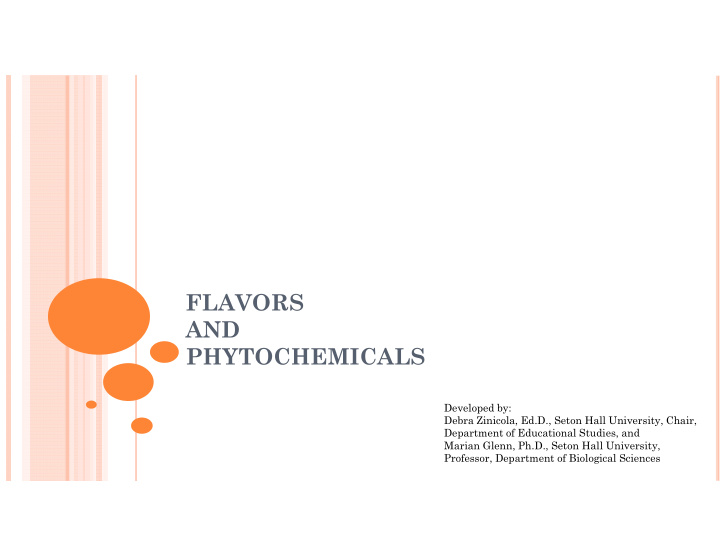



FLAVORS AND PHYTOCHEMICALS Developed by: Debra Zinicola, Ed.D., Seton Hall University, Chair, Department of Educational Studies, and Marian Glenn, Ph.D., Seton Hall University, Professor, Department of Biological Sciences
S OME TERMS AND DEFINITIONS herbs: the dried, leafy parts of a plant spice: pungent or aromatic part of a plant made by drying the bark, seed, fruit, or root antioxidant: chemical that protects against harmful oxidation reactions, often more potent when plant is cooked phytochemical and secondary metabolite: both terms refer to an unusual chemical made by a plant that is not involved in making food or reproduction or other primary processes. Phytochemical is used primarily for chemicals deemed to have a beneficial effect on human health. Secondary metabolite expresses the plant’s point of view. Chemicals that are beneficial to the plant may be harmful to those eating the plant; this includes chemicals that interfere with the nervous system, such as caffeine and pyrethrum, for example.
T HINKING ABOUT PLANTS AS FOOD Now that we have tasted and rated some of our Tower Garden plants, let’s learn about why they may taste different, some more appealing than others. Why do you think plants make all these interesting flavors ? Come up with as many ideas and rationales as possible.
T HINKING ABOUT P LANTS AS F OOD What are some examples of plants you know (or secondary metabolites) that have physiological effects in humans, especially effects on the nervous system? Two examples: caffeine and tobacco.
F RUIT AND VEGETABLES ARE GOOD FOR YOU , BUT WHY ? A diet rich in fruit and vegetables offers health benefits reduced risk of cancer (lung, prostate, pancreas, bladder, and breast) reduced risk of cardiovascular disease Plants produce phytochemicals, also called secondary metabolites These chemicals can protect the plant against bacteria, fungi, viruses, and UV light, and deter herbivores. When we eat the plants, these chemicals may have health benefits. Much research is needed to demonstrate the specific physiological effects of phytochemicals in humans.
P ARTICULAR FAMILIES OF PLANTS MAKE PARTICULAR KINDS OF CHEMICALS Mustard family, including cabbage and radishes, makes a chemical that irritates the tongue and sinuses Chili peppers sting Onion family makes eyes tear Citrus family and mint family are refreshing How might these secondary metabolites be useful to the plant that makes them?
BITTER TASTING PLANTS Secondary metabolites that taste bitter are found in: coffee tobacco cacao Of what benefit does having a bitter taste help the plant? How is your answer consistent with their effects on humans?
A NTIOXIDANTS ARE PHYTOCHEMICALS Antioxidants: are often red or yellow. scavenge highly reactive oxygen produced by photosynthesis. are believed to protect people against cancer. have a presence in food that is often increased by cooking. What do you think might be the benefit of antioxidants to the plants?
L EARN MORE ABOUT PLANTS Fruits and vegetables, especially leafy greens, are considered health promoting. Choose four such plants that appeal to you and research their medicinal or health-promoting characteristics for display in a chart (next slide) WebMD Leafy greens WebMD eat more veggies Phytochemicals
P LANT CHART Health Benefits and Phytochemicals How to Consume References (raw, cooked, Name of Plant infusion, etc.)
A DDITIONAL RESEARCH QUESTIONS Compare the flavor and nutritional value of a particular vegetable that is raw vs cooked. Find out how heating (cooking) affects the nutritional value of this food. Use this website or other sources to find information about one of the phytochemicals identified in your chart. WebMD phytonutrients
A DDITIONAL Q UESTION What did you learn about the scientific basis for the dietary advice “Eat more fruits and veggies?”
FOOD FAIR In your groups, prepare a list of some of the edible plants you researched to bring in for a healthy-food tasting fair. Consider how the nutritional value of these foods is optimized and wash, cut, cook (if needed), and prepare your selected foods in an appetizing and attractive manner for others to eat. Each group must present four foods in quantities large enough for everyone to have a small serving. Each dish will be accompanied by a one-page typed sheet, with sources cited, that relates the following information:
FOOD FAIR RESEARCH Name of plant Where it was grown and where it was obtained (if bought) Health benefits and nutritional value How it is best or typically served Phytochemicals and antioxidants in this food and what you learned about them Historical and cultural uses as food and/or medicine How varieties of the plant have been developed and modified Food Fair Presentation : You will talk about your plant and encourage others to try it. Be sure to tell them about the highlights of your research findings.
Recommend
More recommend